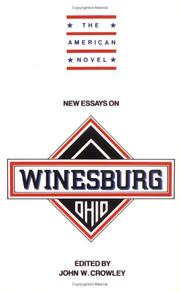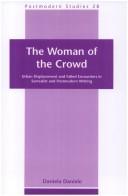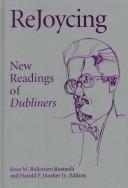Book
Year: 2008 Publisher: Münster : Waxmann Verlag,
Abstract | Keywords | Export | Availability | Bookmark
 Loading...
Loading...Choose an application
- Reference Manager
- EndNote
- RefWorks (Direct export to RefWorks)
Wer die Berlin-Beschreibungen niederländischer und flämischer Künstler des frühen 20. Jahrhunderts liest, gewinnt den Eindruck, ihre Autoren hätten nicht ein und dieselbe, sondern völlig verschiedene Städte bereist. Die einen schwärmen von einer fortschrittlichen Weltmetropole und Hauptstadt der Avantgarde, andere hingegen nehmen Berlin als Zentrum eines immer noch allgegenwärtigen Militarismus wahr, dritte prangern den Verfall der Sitten an. Die vorliegende Studie greift diesen scheinbaren Widerspruch auf und untersucht exemplarisch vier Prosatexte der Autoren Herman Heijermans, J. van Oudshoorn, Hendrik Marsman und Paul van Ostaijen. Wie stellen sie die Stadt dar? Welche Metaphern verwenden sie? Und wie lassen sich die Texte in der Tradition der europäischen Großstadtdarstellung verorten? Eng am Text arbeitend, nuanciert die Untersuchung anhand zahlreicher Zitate, Kommentare und Hintergrundinformationen nicht nur die bisherige literaturhistorische Einordnung der einzelnen Autoren, sondern setzt sich darüber hinaus kritisch mit der in der niederländischen Philologie verbreiteten These eines verspäteten Aufgreifens des Modernismus auseinander.
Book
ISBN: 9780415852531 9780415481557 0415481554 Year: 2013 Publisher: Abingdon Routledge
Abstract | Keywords | Export | Availability | Bookmark
 Loading...
Loading...Choose an application
- Reference Manager
- EndNote
- RefWorks (Direct export to RefWorks)
Book
Year: 2008 Publisher: Münster : Waxmann Verlag,
Abstract | Keywords | Export | Availability | Bookmark
 Loading...
Loading...Choose an application
- Reference Manager
- EndNote
- RefWorks (Direct export to RefWorks)
Wer die Berlin-Beschreibungen niederländischer und flämischer Künstler des frühen 20. Jahrhunderts liest, gewinnt den Eindruck, ihre Autoren hätten nicht ein und dieselbe, sondern völlig verschiedene Städte bereist. Die einen schwärmen von einer fortschrittlichen Weltmetropole und Hauptstadt der Avantgarde, andere hingegen nehmen Berlin als Zentrum eines immer noch allgegenwärtigen Militarismus wahr, dritte prangern den Verfall der Sitten an. Die vorliegende Studie greift diesen scheinbaren Widerspruch auf und untersucht exemplarisch vier Prosatexte der Autoren Herman Heijermans, J. van Oudshoorn, Hendrik Marsman und Paul van Ostaijen. Wie stellen sie die Stadt dar? Welche Metaphern verwenden sie? Und wie lassen sich die Texte in der Tradition der europäischen Großstadtdarstellung verorten? Eng am Text arbeitend, nuanciert die Untersuchung anhand zahlreicher Zitate, Kommentare und Hintergrundinformationen nicht nur die bisherige literaturhistorische Einordnung der einzelnen Autoren, sondern setzt sich darüber hinaus kritisch mit der in der niederländischen Philologie verbreiteten These eines verspäteten Aufgreifens des Modernismus auseinander.
Book
Year: 2003 Publisher: Chicago, Ill. University of Chicago Press
Abstract | Keywords | Export | Availability | Bookmark
 Loading...
Loading...Choose an application
- Reference Manager
- EndNote
- RefWorks (Direct export to RefWorks)
Book
Year: 2008 Publisher: Münster : Waxmann Verlag,
Abstract | Keywords | Export | Availability | Bookmark
 Loading...
Loading...Choose an application
- Reference Manager
- EndNote
- RefWorks (Direct export to RefWorks)
Wer die Berlin-Beschreibungen niederländischer und flämischer Künstler des frühen 20. Jahrhunderts liest, gewinnt den Eindruck, ihre Autoren hätten nicht ein und dieselbe, sondern völlig verschiedene Städte bereist. Die einen schwärmen von einer fortschrittlichen Weltmetropole und Hauptstadt der Avantgarde, andere hingegen nehmen Berlin als Zentrum eines immer noch allgegenwärtigen Militarismus wahr, dritte prangern den Verfall der Sitten an. Die vorliegende Studie greift diesen scheinbaren Widerspruch auf und untersucht exemplarisch vier Prosatexte der Autoren Herman Heijermans, J. van Oudshoorn, Hendrik Marsman und Paul van Ostaijen. Wie stellen sie die Stadt dar? Welche Metaphern verwenden sie? Und wie lassen sich die Texte in der Tradition der europäischen Großstadtdarstellung verorten? Eng am Text arbeitend, nuanciert die Untersuchung anhand zahlreicher Zitate, Kommentare und Hintergrundinformationen nicht nur die bisherige literaturhistorische Einordnung der einzelnen Autoren, sondern setzt sich darüber hinaus kritisch mit der in der niederländischen Philologie verbreiteten These eines verspäteten Aufgreifens des Modernismus auseinander.

ISBN: 052138723X 0521382831 Year: 1990 Volume: *13 Publisher: Cambridge : Cambridge university press,
Abstract | Keywords | Export | Availability | Bookmark
 Loading...
Loading...Choose an application
- Reference Manager
- EndNote
- RefWorks (Direct export to RefWorks)

ISBN: 9042012021 9789042012028 9789004483231 9004483233 Year: 2000 Publisher: Amsterdam : Rodopi,
Abstract | Keywords | Export | Availability | Bookmark
 Loading...
Loading...Choose an application
- Reference Manager
- EndNote
- RefWorks (Direct export to RefWorks)
This book traces the origins of the Postmodern eclectic grammar of linguistic collision back in the Surrealist poetics of ruins. Keeping in mind the images of lost direction in the big city as a central figure in the discussion of both the Modern and Postmodern aesthetics of displacement, Daniele starts comparing the epiphanic encounters of the Baudelairian flâneur in metropolitan Paris - in constant search for the traces of a lost symbolic order - with Breton's enigmatic pursuit of Nadja, the elusive sphinx in the crowd who moves in a mental territory of puzzling condensations and of ineffable objets trouvé. In his visual and written work, Marcel Duchamp was probably the first artist to envision the space of the crowd as a trans-urban, multiple dimension: a cool arena of disjunctive encounters contributing to transform the Surrealist erotic space of desire in a cooler, open field of performance. Deeply influenced by Duchamp's hybrid aesthetics, American Postmodern writers such as Donald Barthelme and Thomas Pynchon, and the performance artist Laurie Anderson, represent metropolis as a “geographical incest”, as a plural, entropic semiosphere which transcends the notion of urban community to become the tolerant receptacle of an ethnic and discoursive multiplicity, an electronic area of linguistic collisions translatable in new fragmented and unfinished narratives. Evoking the assemblages of Abstract Expressionists, the debris of Simon Rodia “junk art”, and the hybrid language of Postmodern architecture, this neo-Surrealist narrative discourse transforms the epiphanic traces envisioned by the Baudelairian and Bretonian heroes in partial parodies, in enigmatic fragments whose ultimate source transcends the narrator's knowledge.. ... The conceptual strategy which is constitutive of these texts implicitly asks the puzzled reader to disentangle the entropic plots, immerging him in the midst of a “linguistic wilderness,” where all opposites - fact and fiction, man and machine, man and female - enigmatically and humorously coexist... Back cover.
City and town life in literature --- Postmodernism (Literature) --- Literary movements --- Literature, Modern
Book
ISBN: 1299201547 0708325343 9780708325346 9781299201545 0708325335 9780708325339 9781783165391 1783165391 9780708325339 Year: 2012 Publisher: Cardiff : University of Wales Press,
Abstract | Keywords | Export | Availability | Bookmark
 Loading...
Loading...Choose an application
- Reference Manager
- EndNote
- RefWorks (Direct export to RefWorks)
This innovative study of the Montréal novel in French looks at how imaginary and material landscapes come together to produce a city of neighbourhoods.
Canadian fiction --- City and town life in literature. --- History and criticism.

ISBN: 0813109493 081314907X 9780813149073 9780813109497 0813120578 9780813120577 1322595569 Year: 1998 Publisher: Lexington : University Press of Kentucky,
Abstract | Keywords | Export | Availability | Bookmark
 Loading...
Loading...Choose an application
- Reference Manager
- EndNote
- RefWorks (Direct export to RefWorks)
""In this volume, the contributors -- a veritable Who's Who of Joyce specialists -- provide an excellent introduction to the central issues of contemporary Joyce criticism.""
City and town life in literature. --- Joyce, James, --- Dublin (Ireland) --- In literature.
Book
ISBN: 1107028035 1107609151 1139989952 1139985345 1139235613 Year: 2014 Publisher: Cambridge : Cambridge University Press,
Abstract | Keywords | Export | Availability | Bookmark
 Loading...
Loading...Choose an application
- Reference Manager
- EndNote
- RefWorks (Direct export to RefWorks)
From the myths and legends that fashioned the identities of ancient city-states to the diversity of literary performance in contemporary cities around the world, literature and the city are inseparably entwined. The international team of scholars in this volume offers a comprehensive, accessible survey of the literary city, exploring the myriad cities that authors create and the genres in which cities appear. Early chapters consider the literary legacies of historical and symbolic cities from antiquity to the early modern period. Subsequent chapters consider the importance of literature to the rise of the urban public sphere; the affective experience of city life; the interplay of the urban landscape and memory; the form of the literary city and its responsiveness to social, cultural and technological change; dystopian, nocturnal, pastoral and sublime cities; cities shaped by colonialism and postcolonialism; and the cities of economic, sexual, cultural and linguistic outsiders.

 Search
Search Feedback
Feedback About UniCat
About UniCat  Help
Help News
News